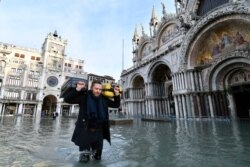Venice has been feeling the effects of global warming, with more frequent events of high tides and rising water levels in recent months.
On Nov. 12, the lagoon city suffered a particularly severe event that caused significant damage to its buildings, churches and cultural heritage.
Now the water levels have receded and tourists during this carnival month are again able to enjoy the city without having to wear rubber waders. But for the authorities, the clean-up operation following the high tides is a work in progress.
Rising waters during the winter months are nothing new for Venetians, who have lived with high and low tides for centuries.
The Tides Center in Venice provides an application so residents and visitors can follow the forecast. The center is able to predict rising water levels, and inform the city’s residents on which areas will go under water and for how long.
But what occurred last Nov. 12 took tides experts by surprise. They described what took place as a rare occurrence caused by a number of factors that led to a “perfect storm.” Morris Ceron, cabinet chief of the Venice mayor's office, said when the tide was at its peak, there also were two winds at maximum strength blowing simultaneously.
He said the significant damage caused to the banks and the boats was the result of the fury of the winds and the high water. Jetties also suffered damage, and Ceron said the emergency required immediate attention because public boat services are essential for mobility in Venice.
He added that Venice is a city that exists and lives on the water but not everyone has a boat.
Ceron said it has been more than two months since that serious November event and authorities just recently have calculated the damages brought by high tides this winter, which were more frequent this year, due to global warming and rising sea levels.
He said the total damage has been estimated at about $546 million, with roughly $437 million to public property and $109 million allotted to privately owned property.
It is expensive to maintain this destination city. Ceron added that residents and authorities were quick to react because they know how to deal with high water, and they take it in stride.
Venice, he said, has always been a city that is a symbol of resilience, and this resilience is the virtue that has allowed it to remain so extraordinary over the years.
Authorities and locals say Venice is safe and tourist should not be concerned because normalcy has returned. In fact, as one walks in its narrow alleys, with the waters receded, it’s as if the high tides never occurred.
Tourists visiting the city should not be surprised if they encounter gondolier drivers in specialized equipment carrying out a delicate clean-up operation inside the canals. Hundreds of kilos of garbage has come to the surface during the work.
Nicola Picco is president of the company Insula, charged by the city council with a separate job on Venice’s canals.
Picco said Insula is carrying out an extensive job that has cost the city more than $546 million over the past two years. He said 30 canals are being dug up to remove 30,000 cubic meters of mud.
The aim is to ensure both hygiene and health conditions, as well as guaranteeing the canals can be safely navigated.










